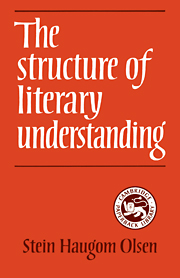Book contents
1 - LITERATURE AND LANGUAGE
Published online by Cambridge University Press: 30 September 2009
Summary
Introduction
Any analysis of the way in which we understand literary works immediately runs up against two basic problems concerning the delimitation of the material on which the analysis should be based. The first concerns the group of people referred to by ‘we’ in the previous sentence. A theorist must have some way of determining the membership of the group containing those people whose literary understanding he wants to analyse. The second problem is: what are the criteria by which the members of the group understand a literary work qua literary work? These two issues may not pose any special difficulties for the theorist once he is aware of their existence, but confusion may appear at a later stage in the discussion if he has not considered them at the outset.
A reasonable answer to the first question is that the literary theorist should be interested in people who are willing and able to use the concept ‘literary work” to distinguish a class of utterances – more appropriately referred to as texts – as having aesthetic properties, an aesthetic dimension, or as constituting aesthetic objects. No further assumptions need be made about the aesthetic properties themselves, not even the assumption that they are ultimately irreducible. The aesthetic properties of texts may be families of other properties occurring in special combinations; nothing is implied about this in the principle of delimitation. Nor does this principle single out any special subgroup of people among those who use the concept of a literary work of art as having superior insight into the aesthetic nature of literary works and therefore having a monopoly of correct opinions about what features of a literary work are aesthetically ‘significant”.
- Type
- Chapter
- Information
- The Structure of Literary Understanding , pp. 1 - 23Publisher: Cambridge University PressPrint publication year: 1978



